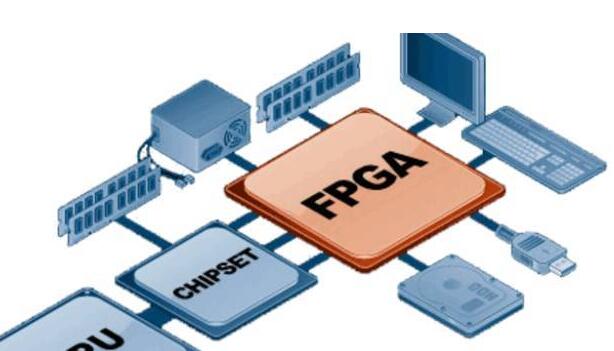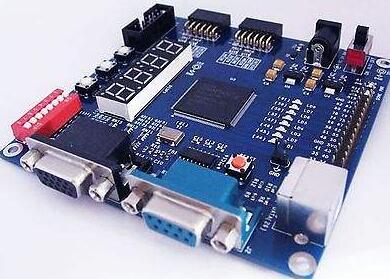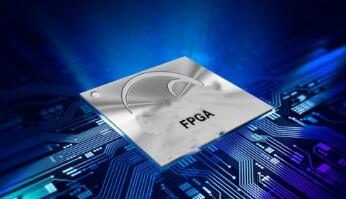FPGA (Field Programmable Gate Array) was invented in 1985 by Ross Freeman, one of the founders of Xilinx. Although there are other companies claiming to be the first to invent PLD, the first FPGA chip XC2064 was invented by Xilinx. This time is almost 20 years later than Moore's famous Moore's Law, but FPGAs have been invented and the subsequent development is faster than most people think. In recent years, FPGAs have always led the leading technology.
Fpga advantages1) Communication high-speed interface design. FPGA can be used to do high-speed signal processing. Generally, if the AD sampling rate is high and the data rate is high, then the FPGA is required to process the data, such as decimation and filtering of the data, reducing the data rate, making the signal easy to handle, transfer, and store.
2) Digital signal processing. Including image processing, radar signal processing, medical signal processing. The advantage is good real-time performance, changing speed with area, much faster than CPU.
3) Greater degree of parallelism. This is mainly achieved through both concurrent and streaming technologies. Concurrency refers to the repeated allocation of computing resources so that multiple modules can perform calculations independently at the same time.

1) FPGA design ASIC circuit, users do not need to shoot production, you can get a shared chip.
2) The FPGA can be used as a mid-sample for other fully custom or semi-custom ASIC circuits.
3) The FPGA has a rich set of internal flip-flops and I/O pins.
4) FPGA is one of the devices with the shortest design cycle, lowest development cost, and minimal risk in ASIC circuits.
5) FPGA adopts high-speed CHMOS technology, low power consumption, and can be compatible with CMOS and TTL levels.
It can be said that the FPGA chip is one of the best choices for small-volume systems to improve system integration and reliability. What are the applications of fpga? What is the main direction? Follow the specific small series to find out.

The first direction, which is also the traditional direction, is mainly used for the design of high-speed interface circuits for communication equipment. This direction is mainly to use FPGAs to process high-speed interface protocols and complete high-speed data transmission and reception and exchange. Such applications usually require the use of FPGAs with high-speed transceiver interfaces. At the same time, designers are required to understand high-speed interface circuit design and high-speed digital circuit board level design, have EMC/EMI design knowledge, and a good analog circuit basis, and need to be solved at high-speed transceivers. The signal integrity issues that arise in the process. The initial and most extensive application of FPGA is in the communication field. On the one hand, the communication field needs high-speed communication protocol processing methods. On the other hand, the communication protocol is being modified at any time, and it is not suitable for making a special chip. Therefore, the FPGA that can flexibly change functions becomes the first choice. More than half of the applications for FPGAs to date have been in the communications industry.
The second direction can be referred to as digital signal processing direction or mathematical calculation direction, because this direction has greatly exceeded the scope of signal processing. For example, as early as in 2006, we heard that the United States used FPGAs for financial data analysis, and later saw the use of FPGAs for medical data analysis. In this direction, FPGA designers are required to have a certain degree of mathematics, to be able to understand and improve the more complex mathematical algorithms, and to make use of various resources within the FPGA to enable them to become actual operational circuits. At present, what is really being put into practical use is still in the field of wireless signal processing, channel coding and decoding, and image signal processing in the field of communications. Research in other fields is underway. The reason why there are not a lot of practical reasons is because financial and medical studies are not Learn this stuff. However, it has recently been discovered that many doctors in electronic engineering and computer science and technology in Europe and the United States have transferred to the financial industry to carry out financial signal processing. It is believed that with the increase in the number of people transferred, the mathematical calculation function of FPGA in other fields will be better exerted. It is also intended to do some research in these areas. However, I am afraid that learning finance and studying medicine in China are rarely used even in mathematics. Needless to say, using FPGAs to help them complete mathematics operations, this issue can only be discussed once again.
The third direction is the so-called SOPC direction. In fact, this is strictly within the scope of FPGA design. It is just the underlying hardware environment of an embedded system built using the FPGA platform, and the designer is mainly on the top For embedded software development. The design time for the FPGA itself is quite small. But if it comes to the need to do specialized algorithm acceleration in the FPGA, it actually requires knowledge in the second direction, and if you need to design a dedicated interface circuit, you need to use the first direction of knowledge.
The current direction of SOPC development is far inferior to the first and second directions. The main reason is that SOPC is mainly based on FPGA, either a "soft" processor is implemented in the FPGA's internal resources, or it is embedded in the FPGA. Processor core. However, most embedded designs use software as the core. Looking at the current hardware development situation, most of the interfaces are standardized and do not require so much FPGA logic resources to design too complex interfaces. Moreover, it seems that SOPC-related development tools are still very imperfect. Various embedded processor development tools represented by ARM have long since become popular. Most ARM-based SOC chips provide most of the standard interfaces. A large number of series of single-chip/embedded processors provide the hardware acceleration circuits required by related industries, and few occasions require specialized custom hardware. It is usually in some special industries that there are very urgent needs in this area. At present, Xilinx has embedded the ARM core of ARMcortex-A9 into the FPGA. In the future, it will greatly promote the development of embedded technology. However, do not forget that many old-fashioned 8-bit microcontrollers are still mixed in the embedded field. The difference in hardware and more is to reflect the value of software differences.

First, data acquisition and interface logic
1, FPGA application in the field of data acquisition
Since most signals in nature are analog signals, the general signal processing system must include the data acquisition function. A common implementation method is to use an A/D converter to convert an analog signal into a digital signal and then send it to a processor, such as an MCU or a digital signal processor (DSP) for operation and processing.
For low speed A/D and D/A converters, a standard SPI interface can be used to communicate with the MCU or DSP. However, high-speed A/D and D/A conversion chips, such as video decoders or encoders, cannot directly interface with general-purpose MCUs or DSPs. In this case, FPGA can complete the glue logic function of data acquisition.
2, FPGA in the field of logic interface applications
In actual product design, data communications with the PC are required in many cases. For example, the collected data is sent to the PC for processing, or the processed results are passed to the PC for display. The interface between the PC and the external system is relatively rich, such as ISA, PCI, PCI Express, PS/2, USB, and so on.
Traditional design often requires a dedicated interface chip, such as a PCI interface chip. If more interfaces are needed, more peripheral chips are needed, and the size and power consumption are relatively large. With the FPGA solution, the interface logic can be implemented inside the FPGA, greatly simplifying the design of the peripheral circuit.
In modern electronic product design, memory has been widely used, such as SDRAM, SRAM, Flash and so on. Each of these memories has its own characteristics and uses. Reasonable choice of memory type can achieve the best price/performance ratio of the product. Because the functions of the FPGA can be completely designed, it is possible to implement controllers for various memory interfaces.
3, FPGA application in the level interface field
In addition to TTL and COMS interface levels, new level standards such as LVDS, HSTL, GTL/GTL+, and SSTL are gradually being adopted by many electronic products. For example, the LCD driver interface is generally LVDS interface, digital I/O is generally LVTTL level, and DDR SDRAM level is generally HSTL.
In such a mixed-level environment, if the interface is implemented with a conventional level-shifting device, the circuit complexity will increase. Using FPGAs to support multi-level coexistence features can greatly simplify design and reduce design risk.

Second, high-performance digital signal processing
Wireless communications, software radios, high-definition video editing and processing, etc., place very high demands on the amount of computation required for signal processing. Traditional solutions generally use multiple DSPs in parallel to form a multiprocessor system to meet the needs.
However, the main problem brought by multi-processor systems is that the design complexity and system power consumption are greatly increased, and the system stability is affected. FPGAs support parallel computing, and their density and performance are constantly improving, and traditional multi-DSP solutions can already be replaced in many areas.
For example, an HD video encoding algorithm H.264 is implemented. The use of TI's 1GHz clocked DSP chip requires four chips, while the use of Altera's StraTIxII EP2S130 chip requires only one to complete the same task. The implementation flow of the FPGA is similar to the front-end design of the ASIC chip, which is conducive to the introduction of the back-end design of the chip.
Third, other application areas
In addition to the above application areas, FPGAs also have a wide range of applications in other fields.
(1) Automotive electronics, such as gateway controllers/car PCs, and telematics systems.
(2) Military areas such as security communications, radar and sonar, and electronic warfare.
(3) Test and measurement areas such as communications testing and monitoring, semiconductor automated test equipment, and general-purpose meters.
(4) Consumer products, such as monitors, projectors, digital TVs, set-top boxes, and home networks.
(5) Medical fields such as software radio, electrotherapy, and life sciences.

Silicon Controlled Rectifier (SCR)
Silicon Controlled Rectifier (SCR) is short for silicon controlled rectifier. SCRs are available in one-way, two-way, turn-off, and light control types. It has the advantages of small size, light weight, high efficiency, long life, easy control, etc. It is widely used in occasions such as controllable rectification, voltage regulation, inverter, and non-contact switches and other automatic control and high-power electric energy conversion.
Silicon Controlled Rectifier,Scr Silicon Controlled Rectifier,3 Phase Silicon Controlled Rectifier,Semiconductor Silicon Controlled Rectifier
YANGZHOU POSITIONING TECH CO., LTD. , https://www.cndingweitech.com